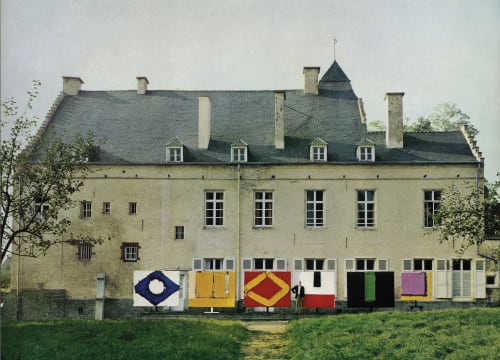Bram Bogart, 1921-2012, was dedicated to exploring the materiality of paint. Like Burri and Fontana, he challenged and blurred traditional notions of painting and sculpture, building three dimensional paintings comprised of mostly natural ingredients including various oils, glue, pigment, powdered chalk, and water. This investigation into the sculptural possibilities of paint led him to use increasingly thick layers, to create nuanced textural surface, exploring balance and disorder, tension and calm, two- and three-dimensionality, colour and structure.
Bogart refused to be pigeon holed into any school or grouping yet he was an artists' artist, exchanging works with his contemporaries Schoonhoven and Fontana. Where Fontana broke the plane by slashing and gauging, Bogart, more than any other pushed outwards towards the viewer, using paint as a sculptural medium. As a young man his heroes were Rembrandt, Permeke and Van Gogh, and later on inspiration came from Mondrian and Van Der Leck. This lineage of lowland painters is very much evident in his work. 1960 was the last year Bogart was able to use stretched canvas before the paint became too heavy, requiring thereafter the use of reinforced wooden supports.
From mid 1961 on, Bogart starts to paint on the floora and the works begin to look like his hero and fellow countryman Van Gogh's brush strokes, but enlarged a thousand fold. This golden period lasts until about 1965 producing some of his most outstanding contributions to the history of painting.
When first confronted with a Bogart, the effect is immediate. In 1965 Fontana wrote 'For many years now I've met the painter Bogart in Paris, and yet I can not forget the impression that I had when watching his paintings the first time when I saw them in his studio'. Previously, in 1959 after exhibiting with Bogart, Niki de Saint Phalle was so blown away by the pregnancy of the white surface of his painting 'Reine des Tauraux' that she was inspired to create her famous shotgun paintings where she violently pierced thick plaster, releasing coloured paint buried within. I personally will never forget seeing them for the first time aged about twelve and immediately rushing off to make my own versions with pigment and poly filler. Bogart makes you want to paint. His works sometimes feel like they were created by an aesthetically astute giant with a suitably large range of utensils for flattening, extruding and brushing cake icing. New observers seem to search for comparisons like this, trying to make sense of the volumus matter, the like of which they may not have encountered. For the most part Bogarts are made of solid home made paint, the colour within and on the surface, referred to by Wim Beeren, Director of Museum Boijmans as a 'concretion of colour', a sort of structural polychromy, rendering the painting not merely abstract colour/s but abstract coloured structure.
To understand the progression of Bogart's paintings one can think of them in terms of a linear, logical almost inevitable progression of the exploration of his medium.
Bogart represented Belgium at Venice Biennale in 1971 and has exhibited widely across Europe from the 1940s onwards, at private galleries and museums. His first solo exhibition in the UK was held at Gimpel Fils Gallery, London, in 1958. Further solo exhibitions include: Musée Boymans-van Beuningen, Rotterdam, Netherlands (1959 and 1984); Palais des Beaux-Arts, Brussels, Belgium (1964 and 1973); Stedelijk Museum, Netherlands (1967); Badischer Kunstverein, Karlsruhe, Germany (1972); Fondation Veranneman, Kruishoutem, Belgium (1985); PMMK Museum of Contemporary Art, Ostend, Belgium (touring) (1995); Fine Art Society, London (2006); Bernard Jacobsen, London (2007 and 2009); Cobra Museum, Netherlands (2012), Vigo Gallery, London (2017) and White Cube, London (2020). His works feature in the collections of many important private collections and museums, including Tate Modern, London, which acquired four works through Vigo Gallery in 2015.

